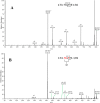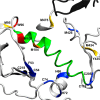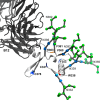Structural Analysis of the Glycosylated Intact HIV-1 gp120-b12 Antibody Complex Using Hydroxyl Radical Protein Footprinting
- PMID: 28102671
- PMCID: PMC5319886
- DOI: 10.1021/acs.biochem.6b00888
Structural Analysis of the Glycosylated Intact HIV-1 gp120-b12 Antibody Complex Using Hydroxyl Radical Protein Footprinting
Abstract
Glycoprotein gp120 is a surface antigen and virulence factor of human immunodeficiency virus 1. Broadly neutralizing antibodies (bNAbs) that react to gp120 from a variety of HIV isolates offer hope for the development of broadly effective immunogens for vaccination purposes, if the interactions between gp120 and bNAbs can be understood. From a structural perspective, gp120 is a particularly difficult system because of its size, the presence of multiple flexible regions, and the large amount of glycosylation, all of which are important in gp120-bNAb interactions. Here, the interaction of full-length, glycosylated gp120 with bNAb b12 is probed using high-resolution hydroxyl radical protein footprinting (HR-HRPF) by fast photochemical oxidation of proteins. HR-HRPF allows for the measurement of changes in the average solvent accessible surface area of multiple amino acids without the need for measures that might alter the protein conformation, such as mutagenesis. HR-HRPF of the gp120-b12 complex coupled with computational modeling shows a novel extensive interaction of the V1/V2 domain, probably with the light chain of b12. Our data also reveal HR-HRPF protection in the C3 domain caused by interaction of the N330 glycan with the b12 light chain. In addition to providing information about the interactions of full-length, glycosylated gp120 with b12, this work serves as a template for the structural interrogation of full-length glycosylated gp120 with other bNAbs to better characterize the interactions that drive the broad specificity of the bNAb.
Conflict of interest statement
The authors declare the following competing financial interest(s): J.S.S. discloses a significant ownership share of Photochem Technologies, LLC, a small company active in the area of hydroxyl radical protein footprinting.
Figures








Similar articles
-
Structural elements of primary CCR5-using HIV-1 gp120 proteins influencing sensitivity and resistance to the broadly neutralizing monoclonal antibody b12.Virology. 2012 Oct 25;432(2):394-404. doi: 10.1016/j.virol.2012.06.024. Epub 2012 Jul 19. Virology. 2012. PMID: 22818780
-
Structural basis for germline antibody recognition of HIV-1 immunogens.Elife. 2016 Mar 21;5:e13783. doi: 10.7554/eLife.13783. Elife. 2016. PMID: 26997349 Free PMC article.
-
Computation-guided backbone grafting of a discontinuous motif onto a protein scaffold.Science. 2011 Oct 21;334(6054):373-6. doi: 10.1126/science.1209368. Science. 2011. PMID: 22021856
-
[Role of the HIV-1 gp120 V1/V2 domains in the induction of neutralizing antibodies].Enferm Infecc Microbiol Clin. 2009 Nov;27(9):523-30. doi: 10.1016/j.eimc.2008.02.010. Epub 2009 May 1. Enferm Infecc Microbiol Clin. 2009. PMID: 19409660 Review. Spanish.
-
Protein Footprinting with Radical Probe Mass Spectrometry- Two Decades of Achievement.Protein Pept Lett. 2019;26(1):4-15. doi: 10.2174/0929866526666181128124241. Protein Pept Lett. 2019. PMID: 30484400 Review.
Cited by
-
Predicting Protein Complex Structure from Surface-Induced Dissociation Mass Spectrometry Data.ACS Cent Sci. 2019 Aug 28;5(8):1330-1341. doi: 10.1021/acscentsci.8b00912. Epub 2019 Jul 2. ACS Cent Sci. 2019. PMID: 31482115 Free PMC article.
-
Illuminating Biological Interactions with in Vivo Protein Footprinting.Anal Chem. 2019 May 21;91(10):6577-6584. doi: 10.1021/acs.analchem.9b00244. Epub 2019 May 7. Anal Chem. 2019. PMID: 31025855 Free PMC article.
-
Variation in FPOP Measurements Is Primarily Caused by Poor Peptide Signal Intensity.J Am Soc Mass Spectrom. 2018 Sep;29(9):1901-1907. doi: 10.1007/s13361-018-1994-y. Epub 2018 Jun 25. J Am Soc Mass Spectrom. 2018. PMID: 29943081 Free PMC article.
-
Radical Footprinting in Mammalian Whole Blood.bioRxiv [Preprint]. 2025 May 28:2024.09.29.615683. doi: 10.1101/2024.09.29.615683. bioRxiv. 2025. PMID: 39386581 Free PMC article. Preprint.
-
Structural Investigation of Therapeutic Antibodies Using Hydroxyl Radical Protein Footprinting Methods.Antibodies (Basel). 2022 Nov 14;11(4):71. doi: 10.3390/antib11040071. Antibodies (Basel). 2022. PMID: 36412837 Free PMC article. Review.
References
-
- Nara P. L.; Garrity R. R.; Goudsmit J. (1991) Neutralization of HIV-1: a paradox of humoral proportions. FASEB J. 5, 2437–2455. - PubMed
Publication types
MeSH terms
Substances
Grants and funding
LinkOut - more resources
Full Text Sources
Other Literature Sources
Miscellaneous

